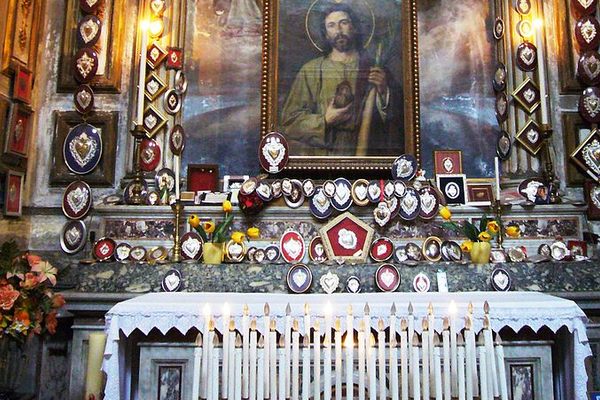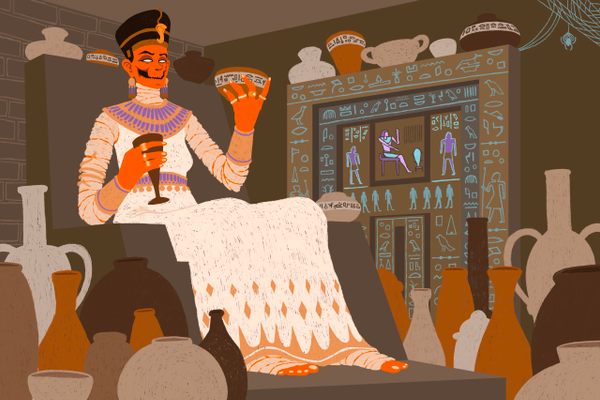Bury My Heart Apart from Me: The History of Heart Burial
Drawing of a vessel in the shape of a heart held by a hand from the 16th century (via Wellcome Library)
Just as you might give a heart-shaped card to a loved one to show your affection, European royalty once bequeathed their actual hearts cut from their corpses to places they cared for. Heart burial had its high point of fashion in the 12th and 13th centuries, although it continues as a romantic funereal tradition to present day.
This trend of heart burial coincided with Middle Ages military campaigns like the Crusades, where people were journeying far from home, and often dying there. Rather than send the whole body back, sometimes just the deceased’s heart was transported, preserved in lead or ivory boxes, often with spices to keep it from smelling too much. Also, you tend to get more prayers and venerations when you’re split up, as the religious would well know from the relics of saints. Occasionally these hearts were even buried in miniature effigies showing tiny knights in full armor. And according to Clare Gittings and Peter C. Jupp’s Death in England: An Illustrated History, “it is possible that some small monuments traditionally claimed to be the tombs of children are in fact heart monuments.”
As Stephen and Thomas Amidon wrote in The Sublime Engine: A Biography of the Human Heart:
“The dispersed burial of monarchs and other dignitaries was common. After Henry I’s death in Normandy in 1135 from eating poisonous eels, his heart was sewn into the hide of a bull for preservation and transported back to England to be buried, while the rest of him was interred where it was. The heart of England’s Richard I — whose nickname, Couer de Lion (Lionheart), is rumored to have come from his ripping out and consuming the heart of a lion to acquire its courage — had his legendary cardiac muscle buried separately from his other remains.”
The tomb of Richard the Lionheart’s heart (photograph by Walwyn/Flickr user)
The brave heart of Richard — a king who may or may not have eaten a lion heart in front of his court, per the 13th century outlandish legend — was buried in Rouen, France. The heart rested there from 1199 until it was exhumed in 2012 and analyzed by scientists. While they weren’t able to find out much about his death, they did find out a lot about heart embalming, including the use of frankincense for a biblical tone along with spices, vegetables, myrtle, daisy, mint, and even some mercury.
This was a more elaborate treatment than most hearts were likely to get. As Eric Edwards of the Pitt Rivers Museum wrote in an article on their own preserved heart, charmingly kept in a crude heart-shaped lead container that was found in Christ Church in Cork in 1863, “it is thought that hearts were removed by those deemed apt for such a chore and these included butchers and cooks.”
Illustration of a what appears to be the heart niche at Leybourne Church (via Wikimedia)
Elaborate, full-size effigies like Richard’s were not uncommon for the highest of royalty — queen consort Eleanor of Castile’s heart interred at Blackfriars in London was memorialized by a huge monument topped by a metal angel that was destroyed in the Dissolution of the Monasteries in the 16th century — but sometimes the memorials were more intimate.
Sir Roger of Leybourne who died in 1271 during the Crusades, has his heart in a tiny casket alongside one for his wife in a niche in Leybourne Church in Kent. Reportedly, Victorians opened the caskets during a restoration, and found his heart enclosed in lead. However, the second for his wife was found to be empty, likely because she remarried after his death.
Monument to René de Chalon (via Wikimedia)
To list the tiny heart burials of the Middle Ages elite would be a monumental task in itself, and to see the most striking of heart burials you have to jump ahead to the 16th century to Bar-le-Duc in France. There is one of the most haunting of heart burials, where a statue of a rotting corpse stretches its left arm up to the heavens with its heart in its hands.
This is a memorial to René de Chalon, Prince of Orange, who was killed at the age of 25 in 1544. The monument by Ligier Richier was completed in 1547, and originally the skeleton held Chalon’s very organ in a heart-shaped red box. Unfortunately, the reliquary was stolen during the French Revolution, and although the mortal terror-inducing statue remains, it just holds a heart facsimile.
Monument to René de Chalon (via Wikimedia)
As a side note, the French Revolution really was an unfortunate time for royal hearts. Louis XIV’s mummified heart was also swiped. Reportedly part of it was accidentally eaten by geologist William Buckland in 1848 when he was examining a silver locket with a strange object in it (he’d apparently put it in his mouth to figure out what it was, perhaps the way he examined rocks). Meanwhile, the heart of the dauphin Louis XVII was kept by a surgeon dissecting the young prince after his death during revolutionary imprisonment, and in 1975 it finally was relocated to the Saint-Denis Basilica in Paris where it is presented in a clear vase.
Heart of the dauphin (photograph by the author)
Grave of Thomas Hardy’s heart (photograph by Michael Day)
While heart burial became something of an oddity by the 14th century — with just outlandish monuments like the one for the Prince of Orange sporadically created — it still made appearances. The idea of being able to be buried in multiple places at once, and the significance of the heart as a source of emotion, was part of its endurance. For example, writer Thomas Hardy’s heart is buried in St. Michael’s churchyard in Dorset, while his ashes are in Westminster Abbey, so that he is both venerated as a British literary icon and rests alongside his family. However, story has long had it that the surgeon who sliced out Hardy’s heart in 1928 stored it in a cookie tin, where his cat discovered it and had it for a meal. Rumor is that an animal heart had to be buried beneath Hardy’s monument instead, although this remains something of legend instead of fact.
And of course, we can’t leave out Percy Bysshe Shelley. After he drowned in 1822, his friends had a makeshift funeral pyre for his body, where Edward Trelawny pulled out a macabre memento from the poet. As Bess Lovejoy wrote in in an article for Atlas Obscura: “Trelawny reported that he reached in and snatched out Shelley’s heart. (Or what he thought was the heart—some say it was more likely the poet’s liver). After a brief custody battle the heart went to Mary Shelley, who kept it in a silk bag in her desk until she died.”
Burial place of Pierre de Coubertin’s heart in Greece (photograph by David Holt)
Heart burial still occurs, sometimes like the Middle Ages royalty to express fondness for a place. Pierre de Coubertin, who died in 1937 and was the founder of the International Olympic Committee and integral in reviving the contemporary Olympic Games, has his heart interred in Olympia, Greece. Just in 2011, the heart of Archduke of Austria and Royal Prince of Hungary Otto von Habsburg was buried in a silver urn in Hungary’s Benedictine Abbey, while his body remained in Vienna, a way to posthumously embrace both sides of his heritage.
There is something hopeful about heart burial, where you feel that some part of you might remain with this organ, even while it has long stopped beating. And even if the bloody heart, a delicate but strong engine for your whole being that’s only a bit bigger than your fist, is just another part of your temporary being that will all someday be gone, there is something oddly romantic about giving such an important piece of you to a beloved place.
The pyramid holding sculptor Antonio Canova’s heart in Venice’s Santa Maria Gloriosa dei Frari (photograph by Anna Fox)
The mourner holding the urn with Canova’s heart (photograph by rjhuttondfw/Flickr user)
The burial place of a heart thought to belong to Robert the Bruce (photograph by Andrew Bowden)
Monument to the heart of François I in the Basilique Saint-Denis in Paris (via Wikimedia)















Follow us on Twitter to get the latest on the world's hidden wonders.
Like us on Facebook to get the latest on the world's hidden wonders.
Follow us on Twitter Like us on Facebook